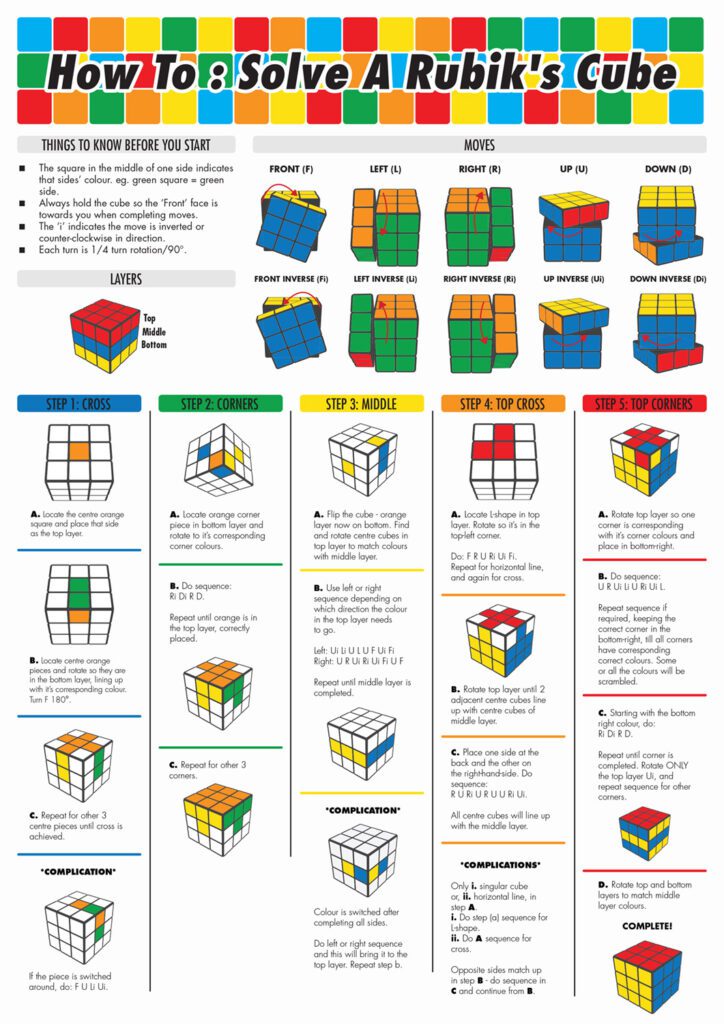The Rubik’s Cube is a challenging puzzle game that can be easily solved by following certain techniques. The cube has six sides, each consisting of nine squares called cubies, which are of three types – center, edge, and corner. Solving Rubik’s Cube involves solving each layer in sequence. The first layer involves placing the white center cubie at the bottom, bringing the white-edge cubies to their correct positions, and then placing the corner cubies correctly. The second layer requires bringing the blue-edge cubies adjacent to the white center cubie at the same level and placing them in their appropriate positions. The third layer involves placing the edge and corner cubies correctly and using an algorithm to flip and rotate them if necessary.
Mastering Rubik’s Cube: Tips and Tricks for Solving Each Layer
Rubik’s Cube is a famous puzzle game that can be challenging to solve, but with the right techniques, it can be solved quickly and easily. The cube is made up of several layers that need to be solved in a proper sequence to complete the puzzle. Here are some useful tips and tricks for solving each layer of Rubik’s Cube.
Understanding the Basic Terminology of Rubik’s Cube
Before we dive into solving the layers of the Rubik’s Cube, let’s first understand the basic terminology used in the game. The Rubik’s Cube has six sides, and each side is made up of nine smaller squares, called cubies. There are three types of cubies:
- Center cubies
- Edge cubies
- Corner cubies
Each side of the cube has one center cubie. These cubies do not move relative to the other sides. There are four edge cubies, and each edge cubie connects two sides. Finally, there are four corner cubies, and each corner cubie connects three sides.
Solving the First Layer
The first layer of the Rubik’s Cube is the easiest to solve. Here are the steps to solve the first layer:
- Choose a side to start with – Let’s say we choose the white side as our starting layer.
- Look for the white center cubie and place it at the bottom of the cube.
- Look for the edge cubies that have white in them, and bring them to the bottom layer with the same color center cubie. For example, if you find a blue and white edge cubie, bring it down to the blue center cubie on the bottom layer.
- Place the edge cubie in its correct position – Once you have brought the edge cubie to the bottom layer, move it to its appropriate position. For example, if you have a blue and white edge cubie, place it below the blue center cubie on the left or right side.
- Finally, put the corner cubies in the correct position. You may need to repeat the above steps a few times to get the corner cubies in their correct positions.
Solving the Second Layer
The second layer is a bit tricky, but with the right techniques, it can be solved quickly. Here are the steps to solve the second layer:
- Choose a side to start with – Let’s say we choose the side with the blue center cubie.
- Look for the edge cubies that have blue in them and are adjacent to the white center cubie.
- Bring the edge cubie to the same level as the side it belongs to. If you find a blue and red edge cubie, bring it up to the level of the red side.
- Place the edge cubie in its correct position – Once you have brought the edge cubie up to the appropriate level, place it in the correct position. For example, if you have a blue and red edge cubie, place it between the red and blue center cubies.
- Repeat the above steps for the other three edges to complete the second layer successfully.
Solving the Third Layer
The third layer is the most challenging layer to solve. Here are the steps to solve the third layer:
- Choose a side to start with – Let’s say we choose the side with the white center cubie.
- Look for the edge cubies that have no white in them and place them in the correct position. For example, if you find a green and red edge cubie, place it between the green and red center cubies.
- Flip the edge cubie if required – If you place the edge cubie in the correct position but it is flipped, follow the algorithm (R’ D’ R D) to flip it.
- Place the corner cubies in the correct position – Once you have placed all the edge cubies correctly, you need to focus on the corner cubies. Move the corner cubies to their correct position and use the algorithm (R’ D’ R D) to rotate them if necessary.
Conclusion
Solving Rubik’s Cube can be a challenging but rewarding experience. These tips and tricks will help you solve each layer of the Rubik’s Cube and complete the puzzle successfully. Remember to practice and keep trying – the more you practice, the easier it becomes!
